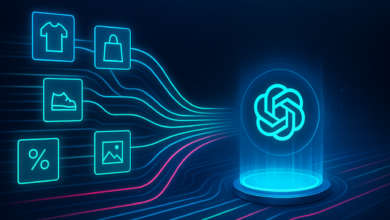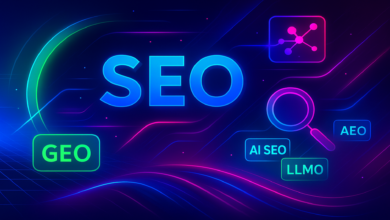Track How AI Is Mentioning Your Brand

▼ Summary
– Generative AI systems like ChatGPT and Perplexity add a new discovery layer to search, where content visibility occurs earlier and may not appear in traditional analytics.
– SEO is evolving into Generative Engine Optimization, requiring tracking of citations and mentions in AI responses while maintaining traditional SEO foundations like structured content and backlinks.
– AI assistants retrieve and cite content chunks rather than ranking pages, prioritizing clarity, attribution, and machine-readable information for inclusion in their answers.
– Measuring AI visibility involves tracking mentions, impressions, and actions in assistants, as citations are volatile and not reported in standard analytics tools.
– Traditional search remains the primary traffic driver, but optimizing for both search and AI retrieval ensures content performs across all surfaces as assistant adoption grows.
The digital landscape is constantly evolving, with generative AI systems like ChatGPT, Copilot Search, and Perplexity introducing a new discovery layer where brand visibility forms long before traditional analytics can capture it. This emerging field, whether called Generative Engine Optimization or AI visibility work, represents the next logical step in search strategy. It doesn’t replace conventional SEO but builds directly upon its foundation.
Search professionals are already monitoring how and when AI assistants reference their content. They analyze which material gets pulled into responses and adjust tactics as these platforms rapidly develop. Think of this as the “answer layer” sitting above the traditional search layer. You still require well-structured content, clean markup, and quality backlinks, these remain the essential building blocks from which AI systems learn. The critical difference lies in how assistants now repackage and present that information directly within conversations, sidebars, and application interfaces.
Ignoring this new visibility layer means missing where audience discovery increasingly occurs. Tracking how assistants mention, cite, and utilize your content provides the first measurable insights into this expanding digital presence.
The Challenge of Unseen Citations
Platforms like Perplexity incorporate numbered citations linking to original sources. OpenAI’s ChatGPT Search now includes website links within its answers, while Microsoft’s Copilot Search similarly pulls from multiple sources and cites them in summarized responses. Google’s own documentation confirms that eligible content can surface within AI Overviews. Each system has developed its own citation methodology, yet none report this activity through standard analytics tools.
This creates a significant visibility gap. Your brand could be referenced across numerous generative answers without your knowledge. These represent modern zero-click impressions that never register in Search Console. To fully grasp brand visibility today, we must measure mentions, impressions, and user actions within these AI environments.
Complicating matters further are content licensing agreements. OpenAI’s partnerships with publishers like Associated Press and Axel Springer might influence citation preferences in ways that remain invisible to external observers. Understanding not just your own performance, but which competitors are being cited and why, has become essential strategic intelligence.
The Importance of Mentions and Actions
Traditional SEO relies on impressions and clicks to gauge performance. Within AI assistants, we encounter similar dynamics without official reporting channels.
Mentions occur when your domain, brand name, or content appears in a generative answer. Impressions happen when that mention displays to a user, regardless of whether they click through. Actions represent when someone actually clicks, expands, or copies the reference to your content.
These metrics shouldn’t replace your existing SEO measurements. Instead, they serve as early indicators that your content possesses sufficient authority to power assistant responses.
Looking ahead to projected adoption curves, assistants are expected to reach approximately one billion daily active users by 2026, embedding themselves into phones, browsers, and productivity tools. This doesn’t signal the end of traditional search, but rather that discovery is increasingly happening before the click. Measuring assistant mentions allows you to observe these initial interactions long before analytics data arrives.
The Enduring Value of Traditional SEO
Let’s maintain perspective: traditional search continues driving the majority of web traffic. Google processes over 3.5 billion searches daily. By comparison, Perplexity handled 780 million queries during May 2025, roughly what Google manages in about five hours.
The data clearly shows that AI assistants currently function as a small but rapidly growing complement to search, not a replacement. However, if your content already ranks well in Google, it’s simultaneously being indexed and processed by the systems that train these assistants. Your optimization efforts naturally support both surfaces. You’re not starting from scratch but expanding what you measure.
From Ranking to Retrieval
Search engines rank entire pages, while assistants retrieve specific content chunks. Ranking represents an output-aligned process where the system identifies the best available page to match search intent. Retrieval operates differently, it’s pre-answer-aligned, with the system assembling information before the final answer takes shape.
When optimizing for ranking, you compete for visibility among other pages. When optimizing for retrieval, you strive for inclusion in the model’s working set before the answer even exists. You’re fighting for participation rather than position.
This explains why clarity, attribution, and structure carry greater importance in this environment. Assistants preferentially pull content they can quote cleanly, verify confidently, and synthesize quickly.
For an assistant to cite your site, your content typically must meet three conditions: it answers questions directly without filler, remains machine-readable and easy to summarize, and carries provenance signals the model trusts, clear authorship, timestamps, and reference links.
These concepts aren’t revolutionary. They represent the same best practices SEO professionals have valued for years, now tested earlier in the decision chain. Where you previously optimized for visible results, you now optimize for the raw materials that construct those results.
Understand that citation behavior proves highly volatile. Content cited today for a particular query might not appear tomorrow. Assistant responses can shift due to model updates, new content entering indices, or weighting adjustments occurring behind the scenes. This instability means you’re tracking trends and patterns rather than guarantees.
Identifying Citation Opportunities
Not all content possesses equal citation potential. Assistants excel at responding to informational queries like “how does X work?” or “what are the benefits of Y?” They prove less relevant for transactional queries such as “buy shoes online” or navigational queries like “Facebook login.”
If your content primarily serves transactional or branded navigational intent, assistant visibility may matter less than traditional search rankings. Focus measurement efforts where assistant behavior actually impacts your audience and where you can realistically influence outcomes.
Practical Tracking Methods
- Begin with manual testing using prompts aligned with your brand:
- “What is the best guide about [topic]?”
- “Which companies provide tools for [task]?”
- “Who explains [concept] most clearly?”
- Run identical queries across ChatGPT Search, Perplexity, and Copilot Search. Document when your brand or URL appears in their citations or answers. Record the assistant used, the prompt, the date, and any available citation links. Screenshots provide valuable evidence. You’re establishing a visibility baseline rather than conducting scientific research.
- After gathering initial examples, repeat the same queries weekly or monthly to track changes over time.
Automation presents another option. Some platforms offer API access for programmatic querying, though costs and rate limits apply. Tools like n8n or Zapier can capture assistant outputs and push them to spreadsheets, creating records of when and where you were cited.
- Don’t limit tracking to your own performance. Competitive citation analysis reveals equally valuable insights. Note who else appears for your key queries, what content formats they use, and what structural patterns their cited pages share. Are they employing specific schema markup or content organization that assistants favor? This intelligence shows what assistants currently value and identifies coverage gaps in your market.
Estimating Impression Volume
While official impression data remains unavailable, we can infer visibility through several methods:
- Examine query types where you appear in assistants, are they broad, informational, or niche?
- Use Google Trends to gauge search interest for those same queries. Higher volume suggests more users likely encounter AI answers.
- Track response consistency across assistants. Appearance in multiple systems for similar prompts indicates higher impression potential.
- Remember that impressions in this context mean assistant-level exposure, your content appearing in answer windows even if users never visit your site.
Monitoring User Actions
Actions represent the most challenging metric to track, though not because assistant ecosystems completely hide referrer data. The reality proves more nuanced.
Most AI assistants (Perplexity, Copilot, Gemini, and paid ChatGPT users) do send referrer data visible in Google Analytics 4 as sources like perplexity.ai/referral or chatgpt.com/referral. These appear in standard GA4 Traffic Acquisition reports.
The primary challenges include:
Free-tier users typically don’t send referrers. Free ChatGPT traffic arrives as “Direct” in analytics, indistinguishable from bookmark visits or typed URLs.
No query visibility exists. Even when you identify the referrer source, you can’t see what question prompted the AI to reference your site.
Current volume remains modest. AI referral traffic typically represents 0.5% to 3% of total website traffic, making patterns difficult to distinguish from background noise.
Improve your tracking through these methods:
- Establish dedicated AI traffic monitoring in GA4 using custom explorations or channel groups with regex filters to isolate major platform referrals.
- Add identifiable UTM parameters when you control link placement, providing additional attribution clarity.
- Monitor “Direct” traffic patterns. Unexplained spikes to commonly cited landing pages may indicate free-tier AI users clicking through without referrer data.
- Track which landing pages receive AI traffic to identify content that systems find valuable enough to reference.
- Watch for copy-paste patterns in social media, forums, or support tickets that match your content language exactly, potential indicators of text copied from assistant summaries.
These tactics help construct a clearer picture of AI-driven actions despite imperfect attribution. Recognize that some AI traffic remains visible (paid tiers, most platforms) while some stays hidden (free ChatGPT), and your objective involves capturing as much signal as possible from both sources.
Indicators of Machine-Validated Authority
Machine-Validated Authority (MVA) functions as an internal trust signal used by AI systems when selecting sources. While we can’t directly observe MVA, we can monitor correlated indicators:
- Citation frequency across different queries
- Presence within multiple assistant platforms
- Citation source stability (consistent URLs, canonical versions, structured markup)
Repeat citations or multi-assistant consistency serve as proxies for MVA, indicating systems increasingly recognize your content as reliable.
Current Platform Benchmarks
- Perplexity reports nearly 10 billion annual queries across its user base, meaningful visibility potential despite being smaller than traditional search.
- Microsoft’s Copilot Search integrates directly into Windows, Edge, and Microsoft 365, exposing millions of daily users to summarized, cited answers within their workflow.
- Google’s AI Overviews create another surface where your content can appear without click-throughs. Their documentation confirms that structured data helps make content eligible for inclusion.
These developments reinforce that SEO still matters tremendously, but now extends far beyond your own website.
- Building Your Tracking Framework
- Start simply with a basic spreadsheet containing these columns:
- Date of check
- Assistant platform (ChatGPT Search, Perplexity, Copilot)
- Prompt used
- Citation found (yes/no)
- URL cited
- Competitor citations observed
- Notes on phrasing or positioning
Include screenshots and links to full answers as evidence. Over time, patterns will emerge showing which content themes or formats surface most frequently.
For automation, configure workflows in n8n that execute controlled prompt sets weekly and log outputs to your spreadsheet. Even partial automation saves time, allowing greater focus on interpretation rather than data collection. Use this collected data to supplement what you track through analytics platforms like GA4.
Realistic Resource Allocation
Before heavily investing in assistant monitoring, carefully consider resource allocation. If assistants drive less than 1% of your traffic and you operate with a small team, extensive tracking might constitute premature optimization. Concentrate on high-value queries where assistant visibility could materially impact brand perception or capture early-stage research traffic that traditional search might miss.
Quarterly manual audits might suffice until the channel reaches meaningful scale. The goal involves building baseline understanding now so you’re prepared when adoption accelerates, not obsessively tracking negligible traffic sources daily.
Effective Internal Reporting
Executives typically prefer concrete examples over theoretical discussions about visibility layers. Show them screenshots of your brand cited within ChatGPT or Copilot alongside Search Console data. Explain that this represents a new front end for existing content rather than another algorithm update.
Frame findings as additive reach. Demonstrate how company expertise now surfaces in new interfaces before clicks occur. This positioning maintains support for SEO initiatives and establishes your role in tracking emerging trends.
Legal and Ethical Considerations
Citation practices exist within an evolving legal landscape. Publishers and content creators have raised copyright and fair use concerns as AI systems train on and reproduce web content. Some platforms have responded with licensing agreements while legal challenges progress through courts.
This environment might influence how aggressively platforms cite sources, which sources they prioritize, and how they balance attribution with user experience. The frameworks we build today should remain flexible as these dynamics develop and the industry establishes clearer norms around content usage and attribution.
Interpreting the Signals
AI assistant visibility currently functions as a minor but growing trust signal rather than a major traffic source. By measuring mentions and citations now, you establish an early-warning system. You’ll identify when your content begins appearing in assistants long before analytics tools detect the trend.
When 2026 arrives and assistants become daily habits for millions, you won’t need to react to the adoption curve. You’ll already possess data showing how your brand performs within these emerging systems. The growth has already begun, explosive and poised to impact consumer behavior. Now represents the moment to incorporate this knowledge into daily planning and preparation.
Final Perspective
Traditional SEO remains your foundation. Generative visibility operates above it. Machine-Validated Authority functions within the systems themselves. Monitoring mentions, impressions, and actions represents our starting point for measuring what previously remained invisible.
We historically measured rankings because that’s what we could observe. Today, we can measure retrieval for the same reason. This simply represents the next evolution of evidence-based SEO. Ultimately, you cannot improve what you cannot measure. While we cannot see how trust gets assigned inside AI systems, we can observe each system’s outputs.
Assistants haven’t replaced search. They simply demonstrate how visibility behaves when the click disappears. By measuring your presence across these layers now, you’ll recognize when the slope begins changing and already stand ahead of the curve.
(Source: Search Engine Journal)





